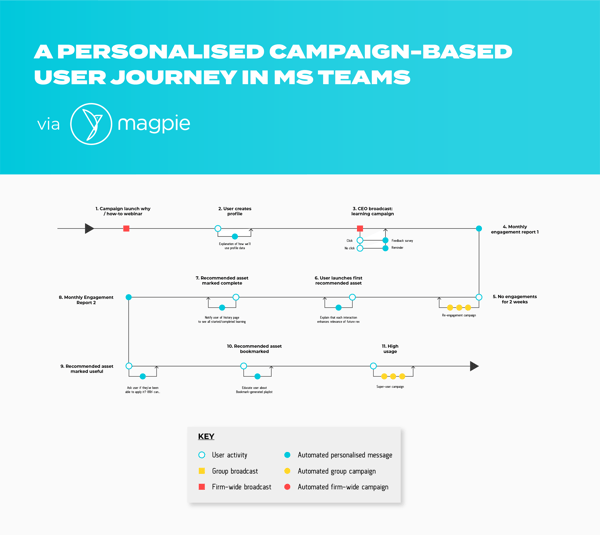TLDR: Teams is more popular than ever. It makes sense to be able to deliver learning experiences there rather than on yet another platform. But a superficial integration with Teams will not be enough. Integrations need to be meaningful. You will need a configurable, intelligent, personalized omnichannel campaign. Filtered does that.
75 million people are now using Microsoft Teams. This is up from 44 million in mid-March, 20 million in Nov 2019 and 13m in July 2019. Large numbers and high growth rates are shouted about all the time in business but this is truly phenomenal and exceptional. This growth is substantially down to the dramatically increased remote work from COVID-19 but also because Microsoft has been giving Teams away to corporates as part of O365. The company has now launched a free consumer version so these astronomical numbers will continue to rise through 2020 and beyond.
You don’t want to fight this tide. Leveraging this extremely popular and genuinely consumer-grade technology is a much smarter bet and appropriate outcome than buying a new learning platform. So it makes sense for L&D to be able to deliver via Teams.
But merely having a ‘Teams integration’ won’t achieve business outcomes or even user engagement.
You’ll need to lay the foundations right: understand what you’re trying to achieve and how you’ll measure that, design the right skills framework, select and tag the right content. And though these pillars are foundational, they are usually overlooked in the pressures of business, throes of battle etc. Another key foundation you can't forget to lay is a company wide understanding of everything Teams itself can do.
Then you face the hardest battle in corporate L&D: engagement. 90-something per cent of activity on corporate LMSs is compliance. Pretty much all LMS data you ever see tells this story. So on top of the foundations mentioned above, you’ll need an intelligent, nudge-based, omnichannel, personalised campaign. That’s what Instagram, Twitter, Facebook feeds are, essentially. But we need to work extra hard in L&D because we don’t and can’t lean on clickbait and deliberate awfulness to achieve engagement and outcomes.
The infographic below shows a limited version of what the initial flow of a Filtered-on-Teams campaign can look like, from a user’s point of view (there's a full campaign plan model you can use with your teams further down). Bear in mind that there are actually an infinite number of user journeys:
We’ve been talking about this for over a year now. Here’s what we wrote in April 2019, ‘MS Teams: the near-future of work’. So our Teams integration has a year of thinking and iteration baked in. A lot of the innovation here comes from personalized digital marketing which Lori Niles-Hofmann (friend of ours and someone who influenced our thinking on the above) knows a lot about.
With a campaign like this, you get to combine intelligent personalization with broader-brush communication.
Personalization comes from:
- User activity which informs and updates the user’s skills signature to improve recommendations on Filtered (see items 4, 6, 9, 10, 25 in the illustration)
- Defining specific automated responses for particular activities (see items 13, 15, 21). A great example of this is asking a user to tell us if they’ve been able to apply anything they’ve learnt at work (80% of our users can)
- Scheduled, personalized monthly usage reports
It doesn’t get more meaningfully personalised than this.
But we also bring the right degree of control and influence for the business (L&D or HR or line managers). You can:
- Set up campaigns for particular groups, small or large eg new joiners, Back-To-Workers, long-time staff, departments
- Send broadcast messages eg from the CEO or HR to everyone
- Send any of the notifications described above via Teams or email.
- See reporting via Tableau, run split tests, find and agree actionable insights.
We've put together a full 26 step model of a multichannel engagement campaign. Add your email in the form below and we'll send over a copy.
I think we’re good at sitting down - over an informal Teams call - and listening to your situation before wading in with advice. If that appeals, please be in touch.


